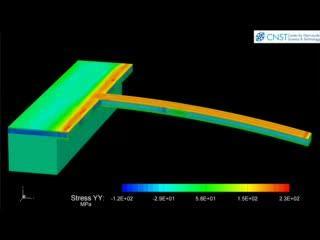From NIST Tech Beat: November 22, 2011
Contact: Mark Esser
301-975-8735
A team of university researchers, aided by scientists at the National Institute of Standards and Technology (NIST), have succeeded in integrating a new, highly efficient piezoelectric material into a silicon microelectromechanical system (MEMS).* This development could lead to significant advances in sensing, imaging and energy harvesting.
A piezoelectric material, such as quartz, expands slightly when fed electricity and, conversely, generates an electric charge when squeezed. Quartz watches take advantage of this property to keep time: electricity from the watch's battery causes a piece of quartz to expand and contract inside a small chamber at a specific frequency that circuitry in the watch translates into time.
Piezoelectric materials are also in sensors in sonar and ultrasound systems, which use the same principle in reverse to translate sound waves into images of, among other things, fetuses in utero and fish under the water.
Although conventional piezoelectric materials work fairly well for many applications, researchers have long sought to find or invent new ones that expand more and more forcefully and produce stronger electrical signals. More reactive materials would make for better sensors and could enable new technologies such as "energy harvesting," which would transform the energy of walking and other mechanical motions into electrical power.
Enter a material named PMN-PT.**
A large team led by scientists from the University of Wisconsin-Madison developed a way to incorporate PMN-PT into tiny, diving-board like cantilevers on a silicon base, a typical material for MEMS construction, and demonstrated that PMN-PT could deliver two to four times more movement with stronger force—while using only 3 volts—than most rival materials studied to date. It also generates a similarly strong electric charge when compressed, which is good news for those in the sensing and energy harvesting businesses.
>>>More

No comments:
Post a Comment